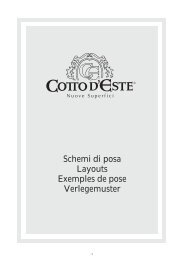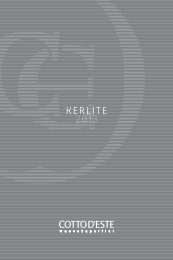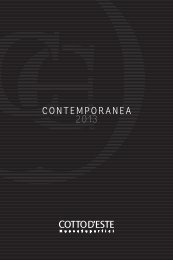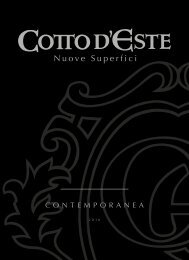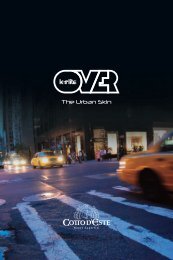catalogo classica - Cotto d'Este
catalogo classica - Cotto d'Este
catalogo classica - Cotto d'Este
Create successful ePaper yourself
Turn your PDF publications into a flip-book with our unique Google optimized e-Paper software.
CARATTERISTICHE TECNICHE - TECHNICAL CHARACTERISTICS - CARACTÉRISTIQUES TECHNIQUES - TECHNISCHE EIGENSCHAFTEN<br />
Sforzo di rottura (S) Breaking strength (S) Charge de rupture (S) Bruchlast (S)<br />
ISO 10545-4 ISO 10545-4 ISO 10545-4 ISO 10545-4<br />
Questo parametro serve per<br />
valutare la capacità della<br />
mattonella di sopportare carichi<br />
statici e dinamici quando è posta<br />
in esercizio. La norma considera<br />
la piastrella come una trave,<br />
posta su due rulli distanti tra loro,<br />
mentre al centro viene applicata<br />
una forza tramite un terzo rullo.<br />
Il carico di rottura è il peso che<br />
viene supportato prima della<br />
rottura della mattonella. Il carico<br />
di rottura effettivo della mattonella<br />
in opera è notevolmente superiore<br />
a quello misurato in laboratorio.<br />
Resistenza all’attacco chimico Resistance to chemical etching Résistance à l’attaque chimique Beständigkeit gegen Chemikalien<br />
ISO 10545-13 ISO 10545-13 ISO 10545-13 ISO 10545-13<br />
Il metodo determina la resistenza<br />
chimica di piastrelle sia smaltate<br />
(GL) che non smaltate (UGL),<br />
utilizzando acidi (cloridrico,<br />
citrico, lattico) e basi (idrossido<br />
di potassio) a bassa (L) e ad alta<br />
(H) concentrazione. La classificazione<br />
viene effettuata come<br />
segue:<br />
Prodotti smaltati (GL):<br />
GLA, GHA: Resistente;<br />
GLB, GHB: Modifica dell’aspetto<br />
della superficie;<br />
GLC, GHC: Perdita parziale o<br />
completa della superficie originale.<br />
Prodotti non smaltati (UGL):<br />
ULA, UHA: Resistente;<br />
ULB, UHB: Modifica dell’aspetto<br />
della superficie;<br />
ULC, UHC: Perdita parziale o<br />
completa della superficie originale.<br />
This parameter is used to assess<br />
the ceramic tile’s capacity to<br />
withstand static and dynamic<br />
loads after laying. The standard<br />
considers the tile as a beam,<br />
placed on two rollers some<br />
distance apart, while a third roller<br />
applies a force to its centre.<br />
The breaking strength is the<br />
weight the tile withstands before<br />
breaking. The actual breaking<br />
strength of a tile after laying is<br />
considerably higher than the<br />
value measured in the laboratory.<br />
The method measures the<br />
chemical resistance of both<br />
glazed (GL) and unglazed (UGL)<br />
tiles, using acids (hydrochloric,<br />
citric and lactic) and bases<br />
(potassium hydroxide) at low (L)<br />
and high (H) concentration. The<br />
classification is as follows:<br />
Glazed (GL) products:<br />
GLA, GHA: Resistant;<br />
GLB, GHB: Changes in<br />
appearance of surface;<br />
GLC, GHC: partial or complete<br />
loss of original surface.<br />
Unglazed (UGL) products:<br />
ULA, UHA: Resistant;<br />
ULB, UHB: Changes in<br />
appearance of surface;<br />
ULC, UHC: partial or complete<br />
loss of original surface.<br />
79<br />
Ce paramètre permet d’évaluer la<br />
capacité qu’a le carreau de supporter<br />
des charges statiques et dynamiques.<br />
La norme considère le carreau<br />
comme une poutre posée sur deux<br />
rouleaux distants l’un de l’autre alors<br />
qu’au centre du carreau est appliquée<br />
une force par l’intermédiaire d’un<br />
troisième rouleau.<br />
La charge de rupture est le poids<br />
supporté avant rupture du carreau.<br />
La charge de rupture effective du<br />
carreau après pose est très nettement<br />
supérieure à celle mesurée en<br />
laboratoire.<br />
ASTM C 648 ASTM C 648 ASTM C 648 ASTM C 648<br />
Il metodo di prova consiste<br />
nell’appoggiare la piastrella sulle<br />
estremità di tre aste cilindriche<br />
oppure su tre cuscinetti a sfera per<br />
piastrelle, aventi un’area facciale<br />
pari a 6,25 pollici² (40 cm²) o area<br />
minore, disposte/i in modo da<br />
formare un triangolo equilatero. È<br />
pertanto applicata una forza di entità<br />
prestabilita al centro del supporto<br />
triangolare. Tale forza è mantenuta<br />
������������������������������<br />
The test method consists of<br />
supporting the tile on the ends<br />
of three cylindrical rods, or on<br />
three ball bearings for tiles having<br />
a facial area of 6.25 in² (40 cm²)<br />
or less, arranged in an equilateral<br />
triangle, and applying force at<br />
��������������������������������<br />
the triangular support, until the<br />
specimen breaks.<br />
La méthode d’essai consiste à<br />
appuyer le carreau sur les extrémités<br />
de trois tiges cylindriques ou sur trois<br />
roulements à billes pour carreaux<br />
ayant une surface faciale de 6,25<br />
pouces² (40 cm²) ou inférieure,<br />
disposées/és de façon à former un<br />
triangle équilatéral. L’essai prévoit<br />
ensuite l’application d’une force<br />
prédéterminée au centre du support<br />
triangulaire, jusqu’à la rupture de<br />
l’échantillon.<br />
La méthode permet de déterminer<br />
la résistance chimique de carreaux<br />
émaillés (GL) et non-émaillés<br />
(UGL) en utilisant différents<br />
acides (chlorhydrique, citrique et<br />
lactique) et des bases (hydroxyde de<br />
potassium) à basse (L) et haute (H)<br />
concentration. La classification est<br />
la suivante:<br />
Produits émaillés (GL):<br />
GLA et GHA: résistant;<br />
GLB et GHB: modification de<br />
l’aspect de la surface;<br />
GLC et GHC: perte partielle ou<br />
totale de la surface d’origine.<br />
Produits non-émaillés (UGL):<br />
ULA et UHA: résistant;<br />
ULB et UHB: modification de<br />
l’aspect de la surface;<br />
ULC et UHC: perte partielle ou<br />
totale de la surface d’origine.<br />
Dieser Parameter dient zur Bewertung<br />
der Fliesenfähigkeit, im verlegten<br />
Zustand statischen und dynamischen<br />
Lasten standzuhalten. Die Norm<br />
bestimmt, dass die Fliese wie<br />
ein Balken auf zwei voneinander<br />
distanzierten a aufliegt und in der<br />
Mitte durch eine dritte Rolle eine<br />
Kraft auf sie aufgebracht wird.<br />
Die Bruchfestigkeit ist das Gewicht,<br />
das vor dem Fliesenbruch ertragen<br />
wird. Die effektive Bruchfestigkeit der<br />
verlegten Fliese ist wesentlich höher<br />
als die im Labor gemessene Bruchfestigkeit.<br />
Die Testmethode besteht darin, die<br />
Fliese auf die Extremitäten von drei<br />
Zylinderstangen abzulegen, bzw.<br />
auf drei Fliesenkugellagern, mit<br />
einer Frontfläche von 6,25 Zoll²<br />
(40 cm²) oder weniger, die in ihrer<br />
Anordnung ein gleichseitiges Dreieck<br />
bilden. Dann wird in der Mitte dieses<br />
dreieckigen Trägers eine Kraft mit<br />
zuvor festgelegtem Ausmaß ausgeübt,<br />
bis die Probe bricht.<br />
Die Methode bestimmt die<br />
Chemikalienbeständigkeit sowohl<br />
glasierter Fliesen (GL) als auch<br />
unglasierter Fliesen (UGL), unter<br />
Verwendung von Säuren (Salzsäure,<br />
Zitronensäure, Milchsäure) und Laugen<br />
(Kaliumhydroxyd) in schwacher (L)<br />
und starker (H) Konzentration. Die<br />
���������������������������������<br />
Glasierte Produkte (GL).<br />
GLA, GHA: beständig;<br />
GLB, GHB: Veränderung des<br />
Aussehens an der Oberfläche;<br />
GLC, GHC: Teilweiser oder vollständiger<br />
������������������������������<br />
Unglasierte Produkte (UGL).<br />
ULA, UHA: beständig;<br />
ULB, UHB: Veränderung des<br />
Aussehens an der Oberfläche;<br />
ULC, UHC: Teilweiser oder vollständiger<br />
������������������������������<br />
Resistenza al gelo Frost resistance Résistance au gel Frostbeständigkleit<br />
ISO 10545-12 ISO 10545-12 ISO 10545-12 ISO 10545-12<br />
I materiali ceramici posati in esterno<br />
subiscono danneggiamenti dovuti al<br />
gelo se possiedono una certa porosità.<br />
Quando l’acqua eventualmente<br />
assorbita ghiaccia, aumenta il<br />
proprio volume determinando forti<br />
sollecitazioni meccaniche interne<br />
che possono tradursi in distacchi di<br />
materiale sulla superficie.<br />
Le mattonelle <strong>Cotto</strong> d’Este sono<br />
ingelive quando, in virtù della<br />
porosità quasi nulla, superano<br />
sempre il test ISO 10545-12 che<br />
prevede 100 cicli gelo/disgelo tra<br />
-5°C e +5°C senza subire nessun<br />
danno.<br />
Ceramic materials laid outdoors<br />
suffer frost damage if their<br />
porosity is above a certain<br />
level. When any water absorbed<br />
freezes, it increases in volume,<br />
generating strong internal<br />
mechanical stresses which may<br />
cause the material to detach<br />
from the underlying surface.<br />
<strong>Cotto</strong> d’Este tiles are frostproof<br />
because, thanks to their porosity<br />
value of virtually nil, they<br />
always pass the ISO 10545-12<br />
test comprising 100 freeze/thaw<br />
cycles between -5°C and +5°C<br />
without suffering any damage.<br />
Les matériaux céramiques posés en<br />
extérieur subissent des dommages<br />
provoqués par le gel lorsqu’ils sont<br />
légèrement poreux.<br />
Lorsque l’eau éventuellement absorbée<br />
gèle, son volume augmente, ce<br />
qui a pour effet d’exercer de fortes<br />
sollicitations mécaniques internes qui<br />
peuvent se traduire par un détachement<br />
des carreaux de la surface<br />
de pose.Leur porosité étant quasi<br />
nulle, les carreaux <strong>Cotto</strong> d’Este sont<br />
ingélifs. Ils ont en effet réussi avec<br />
succès le test 10545-12 qui prévoit<br />
100 cycles de gel/dégel entre -5°C et<br />
+5°C sans subir aucun dommage.<br />
Die in Außenbereichen verlegten<br />
keramischen Materialien werden durch<br />
Frost beschädigt, wenn sie eine gewisse<br />
Porosität aufweisen. Wenn das ggf.<br />
aufgenommene Wasser vereist, wird<br />
dessen Volumen größer, was zu starken<br />
inneren mechanischen Beanspruchungen<br />
führt, die zur Ablösung von Material<br />
��������������������������������<br />
Die Fliesen von <strong>Cotto</strong> d’Este sind<br />
frostbeständig, wenn sie dank ihrer fast<br />
vollkommen fehlenden Porosität immer<br />
den Test nach ISO 10545-12 bestehen,<br />
der 100 Frier- und Tauzyklen zwischen<br />
-5°C und +5°C vorsieht, ohne irgend<br />
welche Schäden davon zu tragen.




